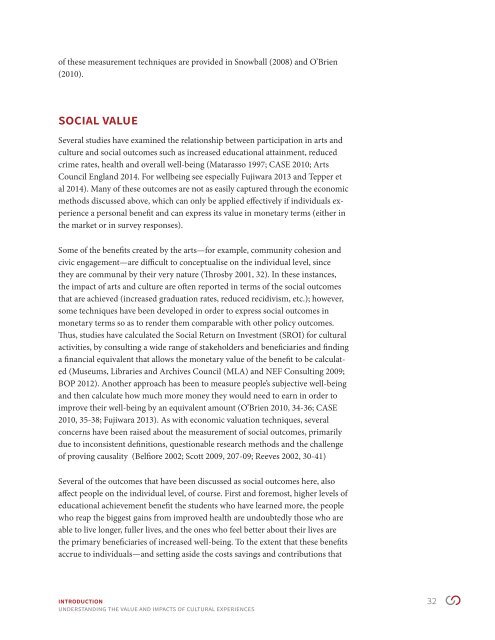aceUVi
aceUVi
aceUVi
Create successful ePaper yourself
Turn your PDF publications into a flip-book with our unique Google optimized e-Paper software.
of these measurement techniques are provided in Snowball (2008) and O’Brien<br />
(2010).<br />
Social value<br />
Several studies have examined the relationship between participation in arts and<br />
culture and social outcomes such as increased educational attainment, reduced<br />
crime rates, health and overall well-being (Matarasso 1997; CASE 2010; Arts<br />
Council England 2014. For wellbeing see especially Fujiwara 2013 and Tepper et<br />
al 2014). Many of these outcomes are not as easily captured through the economic<br />
methods discussed above, which can only be applied effectively if individuals experience<br />
a personal benefit and can express its value in monetary terms (either in<br />
the market or in survey responses).<br />
Some of the benefits created by the arts—for example, community cohesion and<br />
civic engagement—are difficult to conceptualise on the individual level, since<br />
they are communal by their very nature (Throsby 2001, 32). In these instances,<br />
the impact of arts and culture are often reported in terms of the social outcomes<br />
that are achieved (increased graduation rates, reduced recidivism, etc.); however,<br />
some techniques have been developed in order to express social outcomes in<br />
monetary terms so as to render them comparable with other policy outcomes.<br />
Thus, studies have calculated the Social Return on Investment (SROI) for cultural<br />
activities, by consulting a wide range of stakeholders and beneficiaries and finding<br />
a financial equivalent that allows the monetary value of the benefit to be calculated<br />
(Museums, Libraries and Archives Council (MLA) and NEF Consulting 2009;<br />
BOP 2012). Another approach has been to measure people’s subjective well-being<br />
and then calculate how much more money they would need to earn in order to<br />
improve their well-being by an equivalent amount (O’Brien 2010, 34-36; CASE<br />
2010, 35-38; Fujiwara 2013). As with economic valuation techniques, several<br />
concerns have been raised about the measurement of social outcomes, primarily<br />
due to inconsistent definitions, questionable research methods and the challenge<br />
of proving causality (Belfiore 2002; Scott 2009, 207-09; Reeves 2002, 30-41)<br />
Several of the outcomes that have been discussed as social outcomes here, also<br />
affect people on the individual level, of course. First and foremost, higher levels of<br />
educational achievement benefit the students who have learned more, the people<br />
who reap the biggest gains from improved health are undoubtedly those who are<br />
able to live longer, fuller lives, and the ones who feel better about their lives are<br />
the primary beneficiaries of increased well-being. To the extent that these benefits<br />
accrue to individuals—and setting aside the costs savings and contributions that<br />
Introduction 32<br />
UNDERSTANDING the value and impacts of cultural experiences


